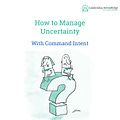Everyone has a plan until they get punched in the mouth. Mike Tyson's excellent response to a reporters question before his fight with Evander Holyfield. And isn't that just true about all of the best laid plans we make? No plan survives contact with the enemy Attributed to Helmuth von Moltke in the 19th century. All such quotes ring true because you know that it concurs with your own experience. On June 6th 1944 the long planned sea and airborne invasion of France began and the months of practice and detailed planning unravelled as parachute forces dropped into unmarked landing spots, gliders landed in wrong areas and thousands of soldiers from many different units found themselves mixed together during the night. A military disaster appeared to be in the making yet just hours later, the original objectives were being accomplished by ad-hoc units who faced much fiercer than expected German resistance. Leaders and soldiers at all levels understood that no matter where they found themselves on landing and no matter who with, they had to form into units, seize bridges and key terrain. The plan had vanished, but good Commander's Intent and superior training allowed leaders and soldiers to improvise and take the initiative to save the mission. What happens in your team at work when a plan changes? Does everyone know what to do next or is there confusion, prevarication and people standing around waiting for direction? Planning is time-consuming and difficult, whether you're planning a military operation, a product launch or planning your career. The military most often uses a concept known as "Commander's Intent" as a key concept to help a plan remain relevant and applicable during chaos in a dynamic ever-changing and resource-constrained environment. That is, they use it for real-life application. In the military, Commander's Intent is the definition and description of what a successful mission will look like to the commander (or CEO). Again, in the military, a Mission Statement describes Who, What, Where, When and Why (the 5W's) of How a mission will be executed. Thus, Commander's Intent describes the vision of the battlefield (or market, for example) at the accomplishment of the mission. Commander's Intent is what success looks like whilst fully recognising that the situation will be chaotic, that there is a lack of complete information, that the enemy changes the situation and anything else that may impact the situation to make the plan completely or partially obsolete when executed. Commander's Intent empowers subordinates to guide their improvisation and to take the initiative to adapt the plan to the changing battlefield environment. It enables the whole team to keep the clear vision of a successful conclusion whilst being agile and taking initiative to change when necessary. Why not just use SMART goals. SMART goals are what we are supposed to be setting, right? The downside of SMART goals is their lack of purpose Goal setting is essential, but even SMART goals are not enough in a rapidly changing, dynamic and shifting environment. SMART goals are terrific, but they don't tell me why, nor what to do should the specific result become impossible given the change in the environment... and there will be a change in the environment. When you take a SMART goal and turn it into an intention reduces the risk of the plan to achieve the goal being rendered useless in the event of unforeseen circumstances. To reduce the risk of becoming unusable, the Commander’s Intent is purposely ambiguous. Regardless of your seniority, any team member can improvise and align their behaviour without jeopardising the mission; and if need be, specify for clarification and without the need for instruction from their leaders. Simplistically, an intent takes a great SMART goal and adds a "so that" to it. For example, Score twice tonight so that we win the match. If the other team score three times, your goal remains achieved yet your mission is stuffe
Share this post

LA 071: How to manage Uncertainty using Command Intent
www.joyatwork.coach
LA 071: How to manage Uncertainty using Command Intent
Apr 27, 2018
Joy@Work Podcast
Helping marketplace leaders #UnStuck their true potential to thrive in life and leadership to build a successful, sustainable business with collaborative, high performance teams and Joy@Work with practical, neuroscience-based AdvantEdge Guides and coaching.
Helping marketplace leaders #UnStuck their true potential to thrive in life and leadership to build a successful, sustainable business with collaborative, high performance teams and Joy@Work with practical, neuroscience-based AdvantEdge Guides and coaching.Listen on
Substack App
RSS Feed
Recent Episodes













LA 071: How to manage Uncertainty using Command Intent